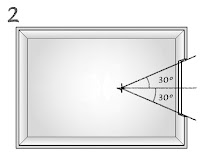Cómo utilizar una carta solar:
Las cartas solares estereográficas nos permiten determinar cuándo
la luz solar incide a través de una ventana o un lucernario.
Una carta solar estereográfica es una representación de la
trayectoria solar a lo largo del año para una latitud determinada. La
representación de una ventana o lucernario sobre una carta solar nos permite
averiguar cuándo se va a producir la incidencia solar a través de dicha abertura.
Carta solar estereográfica a latitud 40º, dibujada por el autor.
A continuación se expone cómo debemos utilizar una carta
solar:
1.- Defina una ventana con una orientación
y un punto de estudio.
Establezca el ángulo de visión desde el
punto de estudio en la vista en planta.
Establezca el ángulo desde el punto de
estudio en la vista en sección.
Traslade ángulos en planta a la carta solar estereográfica.
Traslade ángulos en sección a la carta solar estereográfica.
Defina la ventana en la carta solar.
Como podemos observar, la ventana ocupa una superficie de la
trayectoria solar. Si lo vemos detenidamente, podemos determinar que dicha área
corresponde a una serie de horas, días y meses al año. Dicho intervalo temporal
nos indica cuándo se produce incidencia solar a través de la ventana.
Próximamente explicaremos cómo construir nuestra propia carta
solar. Nos vemos pronto.













